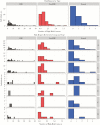Detailed Transmission Network Analysis of a Large Opiate-Driven Outbreak of HIV Infection in the United States
- PMID: 29029156
- PMCID: PMC5853229
- DOI: 10.1093/infdis/jix307
Detailed Transmission Network Analysis of a Large Opiate-Driven Outbreak of HIV Infection in the United States
Abstract
In January 2015, an outbreak of undiagnosed human immunodeficiency virus (HIV) infections among persons who inject drugs (PWID) was recognized in rural Indiana. By September 2016, 205 persons in this community of approximately 4400 had received a diagnosis of HIV infection. We report results of new approaches to analyzing epidemiologic and laboratory data to understand transmission during this outbreak. HIV genetic distances were calculated using the polymerase region. Networks were generated using data about reported high-risk contacts, viral genetic similarity, and their most parsimonious combinations. Sample collection dates and recency assay results were used to infer dates of infection. Epidemiologic and laboratory data each generated large and dense networks. Integration of these data revealed subgroups with epidemiologic and genetic commonalities, one of which appeared to contain the earliest infections. Predicted infection dates suggest that transmission began in 2011, underwent explosive growth in mid-2014, and slowed after the declaration of a public health emergency. Results from this phylodynamic analysis suggest that the majority of infections had likely already occurred when the investigation began and that early transmission may have been associated with sexual activity and injection drug use. Early and sustained efforts are needed to detect infections and prevent or interrupt rapid transmission within networks of uninfected PWID.
Keywords: HIV outbreak; PWID; phylodynamic; transactional sex; transmission network.
Published by Oxford University Press for the Infectious Diseases Society of America 2017. This work is written by (a) US Government employee(s) and is in the public domain in the US.
Figures






Comment in
-
Investigation of Human Immunodeficiency Virus Outbreaks Among People Who Inject Drugs: Timely Diagnosis and Molecular Surveillance are Crucial.J Infect Dis. 2017 Nov 27;216(9):1049-1050. doi: 10.1093/infdis/jix308. J Infect Dis. 2017. PMID: 29029266 No abstract available.
References
-
- Alexander L, Mannion RO, Weingarten B, Fanelli RJ, Stiles GL. Development and impact of prescription opioid abuse deterrent formulation technologies. Drug Alcohol Depend 2014; 138:1–6. - PubMed
-
- Cicero TJ, Ellis MS, Kasper ZA. A tale of 2 ADFs: differences in the effectiveness of abuse-deterrent formulations of oxymorphone and oxycodone extended-release drugs. Pain 2016; 157:1232–8. - PubMed
-
- Des Jarlais DC, Nugent A, Solberg A, Feelemyer J, Mermin J, Holtzman D. Syringe service programs for persons who inject drugs in urban, suburban, and rural areas—United States, 2013. MMWR Morb Mortal Wkly Rep 2015; 64:1337–41. - PubMed
-
- Strathdee SA, Beyrer C. Threading the needle–how to stop the HIV outbreak in rural Indiana. N Engl J Med 2015; 373:397–9. - PubMed
-
- McFarlane T. Emergence of acute Hepatitis C in young Indiana residents who inject drugs [Internet]. Indianapolis, IN: Indiana State Department of Health, 2011. http://www.in.gov/isdh/files/HCV_Cluster_Investigation_-Final.pdf. Accessed 1 December 2016.
Publication types
MeSH terms
Substances
LinkOut - more resources
Full Text Sources
Other Literature Sources
Medical

